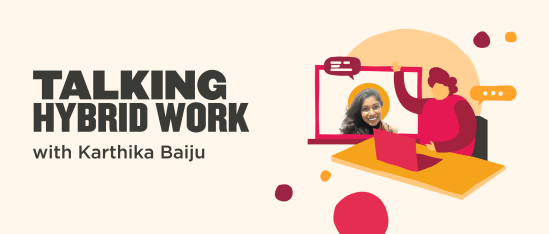Karthika Baiju’s curiosity about people—the relationships they form, the why’s of what motivates them—led her to a career in HR. She’s Head of People at Vita Mojo, which provides digital solutions for the hospitality industry. After a lengthy lockdown in the UK, the Vita Mojo office is finally open, and while Karthika and the People Team plan for the worst, they’ve been happily surprised to find that the worst is yet to materialize. People are happy and energized to be back in the office. Instead of anxious feelings, there’s an exciting buzz as coworkers are eager to take relationships off-screen and enter the next great experiment: hybrid work.
A hybrid work model is more complicated than the fully remote one we’ve gotten used to. Employers are a long way from knowing how it will work, what exactly it will look like, or what new challenges it will create.
The question of who comes into the office and when is the first place to start, but there are lots more that follow. What work is better done in the office versus remotely? How will meetings be conducted? How can we redesign the office space to accommodate hybrid work? How can we give remote employees the same visibility as those who come into HQ? How can we account for the diversity of working styles? What does company culture look like in a hybrid work world?
How will we know if any of this is working?
We sat down (virtually) with Karthika to hear how Vita Mojo’s HR team is approaching the future of hybrid work and why she’s taking a two-month pause on employee surveys.
Here are the highlights:
1. Building work relationships in a remote setting is very challenging
Simon Sinek says, “Music is what happens between the notes. Trust is what happens between the meetings.” Karthika is a Sinek fan, and this quote articulates her ideas about the relationships we form at work—and why it’s so difficult to build those same relationships in a virtual world.
From an HR perspective, she thinks about finding ways to make up for the in-office interactions and learning through osmosis that people miss out on in remote environments. In the office, employees can see the “big picture” just by sitting next to a coworker at lunch and asking, “So, what are you working on this week?” For new starters and more junior employees, this is especially important. A new hire can benefit just by being around their manager and present for all of the conversations that happen during the workday—missing in a remote environment. “We know that [being in the office] is something that junior people on a team need for organic growth. Some may find it difficult to build trust, and adding a screen can be quite detrimental to establishing that trust,” said Karthika.
2. The office might need a redesign
The design of the office makes a huge difference to people’s mental health and productivity. Karthika says companies should think about why employees want to come into the office and design the space around that. Do you need more meeting rooms for team collaboration, more silent spaces for Zoom calls, or a bigger cafeteria for lunch and learn? Maybe all of the above. In a hybrid work model, HR must make up for the imbalance between remote and in-office work and be intentional in crafting their hybrid work strategies—office layout included.
3. HR has to accommodate for different working styles and personalities
Hybrid work has exposed our different working styles. Some people are thrilled to be back in the office and eager to make connections, while others will have to relearn how to stay productive in a noisy and overstimulating environment. Some have found that they love working from home, while others feel remote work is lonely and isolating.
Age and experience also play a factor here. At VitaMojo, the majority of senior managers asked to work from home 3-4 days per week, while more junior employees asked for 1-2 days of remote work. And while HR can’t accommodate every personality and preference, you can find wide-scale solutions that will help most people. For Vita Mojo, they started with a choice-first approach to coming back to the office. In the future, those solutions might include learning and development programs that will provide new skills and mentorship to junior employees. For now, HR needs to appreciate the different styles of working and build data around how people work before making any major decisions or long-term plans.
4. Productivity will look different now
Productivity in the office looks different than productivity at home. Conversations in the office might seem like stuff that happens between work, but as previously noted, it’s instrumental in building workplace connections. Getting a coffee before a meeting and talking with your coworkers about weekend plans adds to team productivity, and it also feels great to talk to coworkers about life outside of work. Group meetings just flow better in person, and when everyone’s in the same room, the silence in brainstorming sessions feels encouraging, not awkward. But all of this social energy can be draining. Karthika noted that data from Geekbot found that employees were more tired the day after being in the office. HR and managers have to be aware of the highs and lows of being back in the office and give people time to relearn how to balance it all. Part of this can be rethinking what productivity looks like for hybrid work.
Recommended For Further Reading
5. Surveying and testing is great, but wait a minute
One month ago, Vita Mojo reopened its offices for employees, and as Karthika said, “People feel great now, but that can all change.” When it comes to bringing people back to the office, the stakes are very high. HiBob conducted a global survey and found that 36% of the workforce is likely to quit their jobs if forced back to the office. HR teams know that they have to go the extra mile during transitional periods to make people feel supported. So the temptation is to survey your people as much as possible. Not so fast.
“HR needs to give people time to adapt to the new work style and only then ask them to think about how we can make it better,” said Karthika. She said any data you find now would likely go out the window in two months, which is why it’s best to wait.
“Asking people to reflect is sometimes better than asking for someone’s thoughts at the moment. Our feelings can change from day to day. Hybrid work needs a long-term strategy, so we need people to think past the current moment, and once they’ve gotten a feel for everything, to then think ahead,” she said.
6. Everything can change, so continue to test and measure
The world of work is changing every day, and that means HR teams need to remain agile and, as Karthika says, plan for the worst and hope for the best. HR needs to build the processes and gather the data it needs to keep its finger on the pulse and get ahead of any major changes that can disrupt employees.
“We can’t ask questions all the time or cater to every single person, but we can create resources to let us know when things aren’t going right,” said Karthika. For her team, these resources include metrics such as absenteeism rates, mental health days, and employee usage of chatbots like Geekbot and Spill. At the Vita Mojo office, there are colored lanyards that employees can wear—green, amber, and yellow— to let coworkers know if it’s safe to approach. This is another way for HR to quickly measure employee sentiment and anxieties around being back in the office without sending out a survey or asking employees individually. Think holistically about how you measure the effectiveness of your current hybrid work setup and what KPIs you want to achieve.
There’s no playbook for how hybrid work should look. Hybrid work at your company might look different in six months or a year. For now, HR’s job is to observe, measure, support, and prepare for more changes to come.


